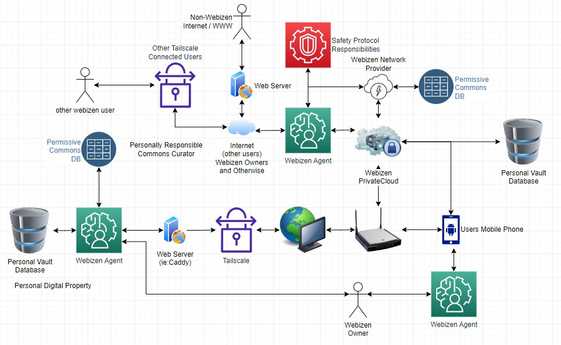Support for Human Agency
Engendering design modals / models, in a manner i broadly describe as 'Human Centric'; which may therefore also be described as Human Centric AI and Human Centric Web; denotes a significant shift in the design topology for how electronic and/or information communications infrastructure and related knowledge & AI systems, are designed and deployed.
At the heart of this topology; in so far as it is being designed with the express intention to support, is a methodology that brings the human agent into the ownership structures as the first-class stakeholders. The effect being that a 'user' purchases their 'webizen' as property, that they own.
In future; the way this concept is intended to be delivered, is via the purchase of a hardware device (that has software in it); but, in the shorter-term - what are the pieces about a webizen that are owned by the purchaser? is it simply, the database? how are the requirements more complicated than what might simply be achieved by ensuring the person owns their own personal database.
Individuals
There are various complexities within this topic and those that in-turn depend upon it (ie: support for webizen agents that are 'owned' by an incorporated entity / legal personality (as distinct to natural legal person)); for now, this document seeks to discuss the considerations as they relate to individuals.
The Diagram Below make an attempt to describe the elements involved.
Description of Diagram Concepts: In the above diagram; there is a Webizen Agent, which is the tooling used to power the ecosystem; this is in-turn plugged into a web-server, that is connected via tailscale to a public point of presence, that is required to support domain-name resolution (DNS).
The consideration becomes; that perhaps there are effectively two seperate databases, one that is a persons 'personal vault' database, which is owned by them and contains the resources that have not been provided to anyone else. Whilst the personal-vault database can be stored on multiple devices, and may contain different amounts of the overall data-volume on each device - this database is owned by the 'webizen owner'...
Seperately, is the permissive commons database, which contains data that has electronic contracts associated to its use & modification, is in-effect a commons system; that is stored in a decentralised manner in-order to support various processing and networking related functional requirements. The contents held in the webizen network providers permissive commons environment may be substantially different to the contents held by a webizen owner; although, any content that is permissively able to be shared with either may be.
The Webizen Network provider may also have an array of safety protocols it is required to operate for reasons that may relate to law or other duties (ie: keeping webizen users safe); and whilst these safety protocols are also sought to be operated by webizen owners, the ecosystem is intended to ensure the choice to do so resides with the webizen owner notwithstanding the fact that there is likely to be implications either way.
In circumstances where there is a group of Webizen Owners who are sharing the same TailScale network; then, it is assumed that the networking topology will be private and therefore not subject to any rules defined by the Webizen Network Provider.
Families
By extension, the design concept might be that each competent natural legal person has their own webizen 'private vault'; and that resources relating to the union of persons, thereby end-up being a form of highly-encrypted resource that's stored in the permissive commons technology ecosystem; with the exception of the systems / records, relating to other human beings, such as children or others whom someone has a relationship of legal and/or medical guardianship...
Guardianship Semantics
This in-turn is intended to provide support for users to employ the webizen related infrastructure as an entity who has individual rights, responsibilities and capacities as an natural legal person to thereby engage with others; form contracts, including those that relate to shared rights as defined via electronic agreements (ie: permissive commons technology related - shared rights / responsibilities).
As far as
General issues that need to be attended to...
**
Need to Establish Legal Identity for all Individuals involved.
If Company, need to establish the Individuals Involved (they need to be KYC’d)
Need to Establish Responsibility for;
a. The Billing Costs of the Account;
b. The Use of the Account and any assigned ‘agents’.
c. Guardianship / supervision related relationships (ie: webizen owned by kids noting - this should be configurable).
The Authorisation Sequence / Methodology used to certify / electronically verify ‘ownership’ assignment of different webizen.
**
